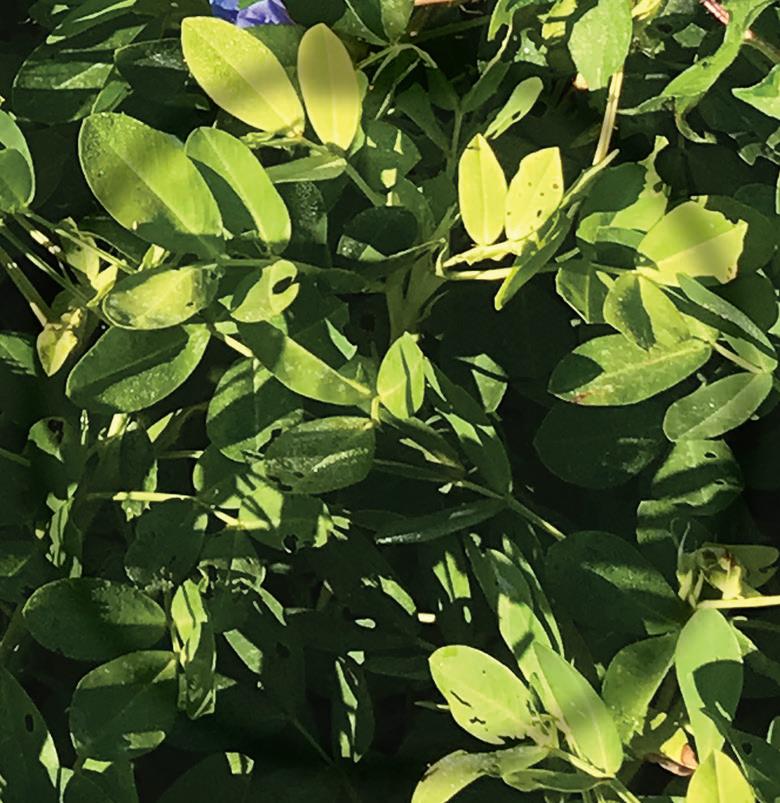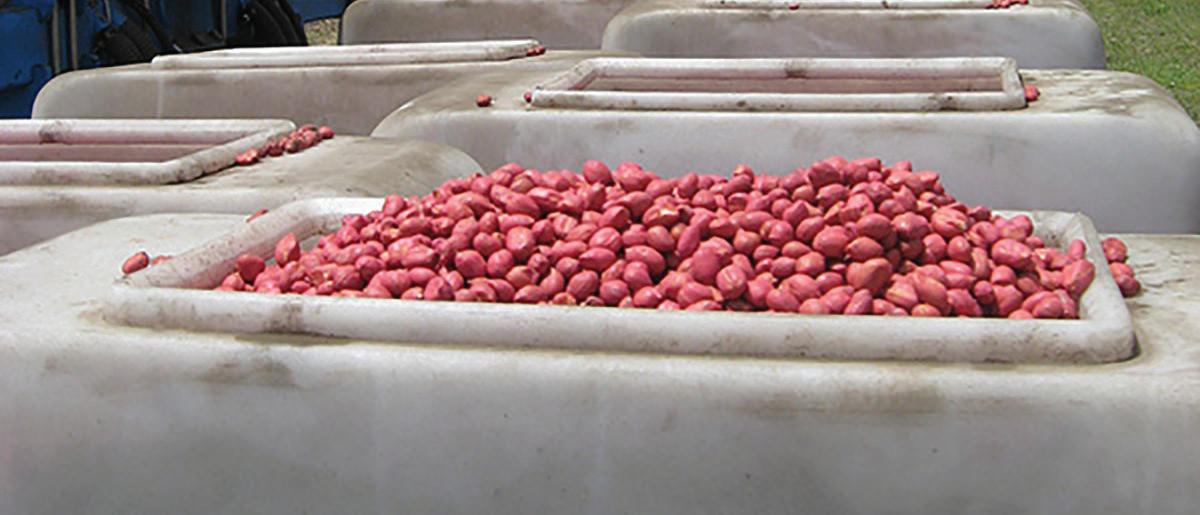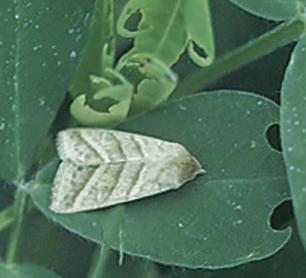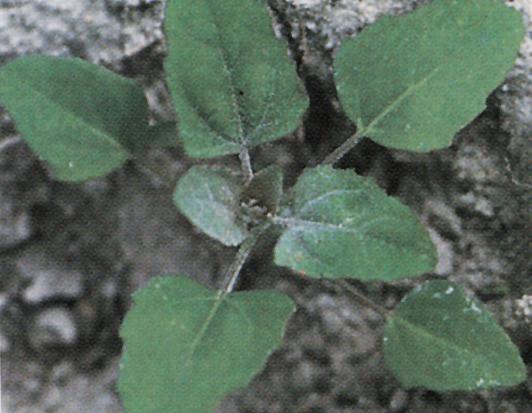

















2023 ONE GROWER PUBLISHING, LLC THE PEANUT PRODUCER'SMARKETING & PRODUCTION MAGAZINE www.peanutgrower.com PEANUT GROWER The JANUARY 2023 Farm Bill Negotiations Begin Field Research O ers These Timely Tips Sustainable Peanut Initiative First-Year Report Pest Management Guide








Looking for a new favorite flavor combo? Try the winning recipe from our Peanut Butter and Chili Cook-off.




































JANUARY 2023 • THE PEANUT GROWER / 3 TWITTER: @PEANUTGROWER 22 4 Editor’s Note A sustainability footprint takes shape 5 News Briefs New leader for House Ag Committee 6 Market Watch Little excitement for early contracting Volume 35 • Number 1 Cover photo by Amanda Huber 2023 ONE GROWER THE PEANUT PRODUCER'SMARKETING & PRODUCTION MAGAZINE www.peanutgrower.com PEANUT GROWER The JANUARY 2023 Farm Bill Negotiations Begin Field Research Offers These Timely Tips Sustainable Peanut Initiative First-Year Report Pest Management Guide Features 8 Farm Bill Discussions Begin How much money will be available for agriculture programs is the big question? 10 Put A Plan Together e expression of Tomato Spotted Wilt Virus comes from a combination of factors. 14 Insect Management Research-based ratings are offered for peanut insecticides. 16 Weed Management Herbicide efficacy ratings will help with product selection. 20 Sustainable U.S. Peanuts Initiative Completes Year One It will take two to three years for a baseline, but much was accomplished in the pilot program. Departments Supplement Look for the Corn South supplement following page 12 in the Alabama, Florida, Georgia and Mississippi versions of e Peanut Grower Planting Tips January 2023 Supplement to Cotton Farming and The Peanut Grower Magazines Southern Production & Marketing Strategies JANUARY 2023 22 Clemson Research Offers Tips For 2023 Plus, a dry summer reduces disease pressure in Arkansas. www.peanutgrower.com PeanutGrower @PeanutGrower @ThePeanutGrower
The Peanut Grower (ISSN 1042-9379) is an agribusiness magazine for U.S. peanut producers. Published in eight monthly issues, January through July and November. Annual subscriptions are $40.00. Single Copy price is $5.00. Annual overseas subscriptions are $70.00, including Canada/Mexico. Periodicals postage paid at at Memphis, Tennessee, and at additional mailing o ices. Copyright © 2023 One Grower Publishing, LLC, all rights reserved except where otherwise noted. The Peanut Grower ® is a registered trademark, which reserves all rights granted by the U.S. Patent and Trademark O ice in association with the registration.
POSTMASTER: SEND ADDRESS CHANGES TO OMEDA COMMUNICATIONS, CUSTOMER SERVICE DEPARTMENT, P.O. BOX 1388, NORTHBROOK, IL 60065-1388. All statements, including product claims, are those of the person or organization making the statement or claim. The publisher does not adopt any such statement or claim as its own, and any such statement or claim does not necessarily reflect the opinion of the publisher. Printed in the USA.
Editor’s Note

A Footprint Takes Shape
In 2022, the Sustainable U.S. Peanuts Initiative platform was ready for enrollment and collection of grower data from the prior season. Although findings have been released, some of which you can read about on page 20, one year of data is a starting point and not enough to make a baseline about the industry’s sustainability efforts.
What those 69 volunteer farmers did was start the process and help refine the platform in which data is input. When a question was not fully understood, they would let Eric Coronel, American Peanut Council’s sustainability director know, and it would be revised, improving the product for future participants. Kudos to them for being a critical part of this effort.
Huber Editor, The Peanut Grower
The sustainability initiative came about because consumers are demanding more information about the food they eat. Not just where it comes from, but how it is grown and what the impact is on the environment. Prior to creating their own platform, the APC joined Field to Market: The Alliance for Sustainable Agriculture, who developed the Fieldprint Platform, a pioneering assessment framework for brands, retailers, suppliers and farmers to measure the environmental impacts of 11 commodity crops. A National Indicators Report, published every five years, helps quantify the efficiency of U.S. farmers and highlights five critical environmental indicators.
According to the 2021 National Indicators Report:
Total yearly U.S. peanut production has increased 166% without a significant increase in peanut acreage.
One Grower Publishing, LLC


875 W. Poplar Ave., Suite 23, Box 305 Collierville, TN 38017
In the early 1980s, a peanut farmer could expect to produce 2,500 pounds of peanuts per acre. Because of improved peanut varieties, research and education, among other advancements, peanut farmers can now grow over 4,000 pounds per acre on average.

The land area needed to produce one ton of peanuts has decreased by 46%, from an average of one acre during the early 1980s to 0.54 acre in 2020.
The water required to achieve an increase in yield compared to non-irrigated yield conditions has decreased by 43%.
Energy use and greenhouse gas emissions required to produce one pound of peanuts have decreased by 55% per pound of peanuts at the field level.
For soil erosion, there was no change when comparing 1980 to 2020. There was a spike in soil erosion in the early 2000s, but since then, soil erosion has been reduced by 31%.
With this information and that collected by the Sustainable U.S. Peanuts Initiative, the industry will have the documentation or “proof” necessary to promote U.S.-grown peanuts as a resource-efficient crop produced by dedicated farmers.
4 / THE PEANUT GROWER • JANUARY
PEANUTGROWER.COM
2023
Scott Monfort Extension Agronomist University of Georgia
Dell Cotton Peanut Growers Cooperative Marketing Assn., Franklin, VA Kris Balkcom Agri-Program Associate Auburn University Dan Anco Extension Peanut Specialist Clemson University
Emi Kimura Extension Agronomist Texas A&M University David Jordan Extension Agronomist North Carolina State University Glen Harris Extension Agronomist University of Georgia Jason Ferrell Extension Weed Specialist University of Florida
EDITORIAL/PRODUCTION Editor Amanda Huber ahuber@onegrower.com Copy Editor Cassidy Nemec cnemec@onegrower.com Art Director Ashley Kumpe Digital Content Manager Katie Guthrie ADMINISTRATION Publisher/Vice President Lia Guthrie (901) 497-3689 lguthrie@onegrower.com Associate Publisher/Editor-In-Chief Carroll Smith (901) 326-4443 Associate Publisher/Sales Scott Emerson (386) 462-1532 semerson@onegrower.com Audience Services Kate Thomas (847) 559-7514 Production Manager David Boyd dboyd@onegrower.com For subscription changes or change of address, call (847) 559-7578 or email peanutgrower@omeda.com
One Grower Publishing, LLC, also publishes Cotton Farming, Rice Farming, Soybean South and Corn South
PRESIDENT/TREASURER
PUBLISHER/VICE PRESIDENT EDITORIAL ADVISORY BOARD ONE GROWER PUBLISHING, LLC
Mike Lamensdorf
Lia Guthrie
Amanda
News Briefs
New Ag Committee Leader
Incoming House Agriculture Chairman G.T. Thompson (R-Pa) laid out some of his top policy priorities for the Farm Bill recently. His top priority is to get the nearly half-trillion-dollar legislation out on time and avoid extending the existing Farm Bill if possible, despite a packed oversight schedule planned.
Other priorities range from boosting agricultural production to nearly double its current rate to pumping the brakes on the Biden administration’s spending on climate-smart agriculture.
Thompson will have a packed schedule and a potentially tough path to getting a Farm Bill done on time as he tries to thread a needle between the democrats on his left and the House Freedom Caucus on his right.
A major issue for Thompson is climate and production. The Farm Bill and American agriculture already have climate benefits, but he says he is open to making tweaks in the legislation that would strengthen those practices. However, these would have to be “innovative, outside the box” solutions. He is sponsoring a bill that would allow the U.S. Department of Agriculture to accept or match private funds to support climate and conservation programs.
Sign Up Now For ARC Or PLC
Agricultural producers can now enroll or change election Agriculture Risk Coverage and Price Loss Coverage programs for the 2023 crop year, two key safety net programs offered by USDA. Producers have until March 15, 2023, to enroll. Additionally, USDA’s Farm Service Agency has issued payments totaling more than $255 million to producers of 2021 crops that have triggered payments through ARC or PLC.

Texas Roasting Co. Fired Up
Texas Roasting Company, Seminole,
Texas, offers salted and flavored packaged peanuts as well as in-shell and brined peanut products. What began as ideas jotted down on a diner napkin has developed into a peanut buying point, a shelling facility and now a peanut roasting plant that produces and markets a variety of peanut products.
“Texas Roasting Company is the only farm-to-fork company in Texas,” says founding partner Jake Teichroeb, who, along with Ben Dyck and Eddie Bergen, created Trico Peanut Company in 2015. Teichroeb said sustainability is the driving force behind both the shelling facility and the roasting company.
In 2015, the Trico partners started talking about creating a buying point. “We could not work out a deal with larger companies, so we decided to become independent and started building storage spaces and from there added shelling facilities,” said Trico President Bergen.

Georgia Peanut Farm Show Plans
Make plans to attend the 46th annual Georgia Peanut Farm Show and Conference, Thursday, Jan. 19, 2023, from 8 a.m. to 2:30 p.m. at the University of Georgia Tifton Campus Conference Center, Tifton, Georgia. The one-day show is free and open to all farmers and industry representatives.
Attendees will have the opportunity to visit with nearly 100 agribusinesses and organizations. Farmers can earn private and commercial pesticide applicator certifications, as well as learn about cutting-edge research and developments during the University of Georgia Peanut Production Seminar and industry-wide sponsored Peanut Seed Seminar.
Farm Show chairman Rodney Dawson says, “I encourage farmers to attend this one-day show in Tifton. The knowledge they will gain from industry representatives and seminars is an investment in the future of their farm.”
The Georgia Peanut Commission, in
In Brief
• New House Ag chairman faces challenges but aims to complete Farm Bill on time.
• Program selection deadline is March 15.
• From buying to roasting, Texas group is the farm-to-fork place for peanuts.
• Nearly $10,000 in prizes awaits farmers attending Georgia Farm Show.
• New Georgia ag commissioner hails from South Georgia.
cooperation with OneBlood, will host a blood drive at the show.
Nearly $10,000 in door prizes will be awarded, as well as a Grand Door Prize, vendor products, certificates and equipment. For more information on the show, contact the Georgia Peanut Commission office at 229-386-3470 or visit www.gapeanuts.com.
Harper Elected Georgia Ag Commissioner
State Senator and seventh generation South Georgia farmer Tyler Harper secured a resounding victory to be the state’s next agriculture commissioner. Harper has been crisscrossing the state for the past year and a half and sharing his positive vision for farmers, producers, consumers and families.
Harper lives in Ocilla, Georgia. He graduated from the University of Georgia with a bachelor’s degree in agricultural engineering and has an associate degree in agriculture from Abraham Baldwin Agricultural College. His election is a win for the peanut industry.
Besides work on the farm and as ag commissioner, he enjoys the outdoors and attends Satilla Baptist Church, where he plays in the band.
JANUARY 2023 • THE PEANUT GROWER / 5 TWITTER: @PEANUTGROWER
Market Watch

Peanut producers look back at the 2022 crop questioning what happened. King cotton was competing for land with unbelievable prices at $1.30 per pound. With inflation rampant and cost of production steadily increasing, the grower worked to reduce inputs when possible.

The weather joined in the battle with a five- to six-week drought across most of the Southeast peanut belt just a most plants were starting to peg. The Southwest production area had little rain all season. Farmers and researchers kept seeing outbreaks of Tomato Spotted Wilt Virus, but it was too late to take any preventive measures.
War in Ukraine was said to be the cause that sent fertilizer prices soaring. Gas and diesel fuel kept getting higher. So many unknowns made a grower wonder about pricing and/or contracting. Was the crop estimate accurate? Was acreage really down 10%, and would prices go higher if the crop was short? The peanut picture is slowly coming into focus.
9%, or 242,531 tons, were for commercial sale at the time, and the remaining 91% was placed in the loan program for $375 per ton.
The quality of the 2022 crop was exceptional. Only .0014% of the crop went Seg. 2 or Seg. 3.
Contracts
Peanut markets remain relatively quiet at the farm level except for uncontracted peanuts. Farmers who did not sign earlier contracts at $500 to $525 per ton were chasing rumors of $625 to $650 perton peanuts with shellers offering mostly $600 per ton maximum. Co-ops offered less-promising dividends. The problem is that the peanuts are in the sheller’s warehouse, and that is the only price option available for uncontracted peanuts.
The higher of the loan rate ($.1775 per pound, or $355 per ton) or market price average ($486 per ton) is deducted from the reference price ($535 per ton). This equals a PLC payment of $49 per ton.

This payment can only be applied to 85% of the peanut farm base. Farm Service Agency payments were verified and paid to the farmer in October 2022.
The U.S. Department of Agriculture has issued a projected market year average price based on world agricultural supply and demand estimates. The projected market year average price for peanuts in August 2022 is $.2650 per pound, or $530 per ton. Deducting $530 from reference price of $535 per ton means the PLC payment next October would be $5 per ton.
Production
The 2022 peanut yield forecast was reduced to 4,090 pounds per acre from 4,145. Farmers reported peanut acreage at 1.4 million acres, down 8.4%. Total production was estimated at 2.88 million tons, down 9.3% from last year. The Federal State Inspection Service had graded 2.7 million tons by Dec. 9. Only
Price loss coverage payments are made when the market year average, which is based on the average prices paid to farmers from August 2021 to July 2022, is below the reference price. The peanut market year average last year was $.2430 per pound, or $486 per ton.
The effective reference price for peanut is $.2675 per pound, or $535 per ton.
The good news from USDA and the Commodity Credit Corporation is that only 1,545 tons remained in the loan in mid-December and are likely sold by now. To begin the market year with 2.56 million tons and have the loan program repaid and peanuts moved into the market is a credit to the USDA team and the buyers, and it merits a renewal in the Farm Bill.
6 / THE PEANUT GROWER • JANUARY 2023 PEANUTGROWER.COM
Little Excitement For Early Contracting On 2023 Crop Leading Marketing Indicators (As of Dec. 12, 2022) 2022 Est. Acreage (-8.4%) ............................................... 1,411,000 acres 2022 Est. Production (- 9.3%) ............................................ 2,885,500 tons 2022 Market Loan .............................................................. 2,568,453 tons 2021-22 Remaining In Loan ..................................................... 1,545 tons 2022 Domestic Usage (3 Mo) ........................................................ – 0.5 % 2022 Exports (8 Mo) ..................................................................... – 9.01 % NATIONAL POSTED PRICE (per ton) Runners -$424.68; Spanish - $413.41; Valencia and Virginias - $428.31 ‘‘Quality of the 2022 crop was exceptional. Only .0014% of the crop went Seg. 2 or Seg. 3.
J. Tyron Spearman Contributing Editor, e Peanut Grower
Market Watch

Domestic Market
Good news on domestic markets as October shows a 3% increase for shelled edible peanuts, and peanut butter buys are up 6.7%. For the three-month period, usage is down 0.5% for shelled edible peanuts, while peanut butter shows a 2.7% increase for the same period. Peanut candy and peanut snacks posted slight declines but are still a strong market volume.
Export Market
Mexico and Canada continue as the best export markets for U.S. peanuts. Mexico is up 13%, and Canada is up 3%. Although China is down 45%, it is still a major market. The Netherlands and Japan continue to grow, although total volume
is down 9% for the eight-month period.
Heading into the holidays, demand for peanuts is very muted. Normally this time of year, the market for the 2023 crop is pretty active, but this year is different. Because of the higher prices for the 2022 crop, the chances of early contracting for the 2023 crop are slim.
2023 Market

Shellers aren’t going to contract and go long on the 2023 crop if buyers will not support the shelled prices, and farmers aren’t likely to accept $450 to $500 for farmer-stock basis. The market is watching two drivers of future prices.

Because of strict COVID-19 protocols in China, which may only loosen slightly this year, don’t expect the Chinese to
show interest in U.S. farmer stock until Fall 2023 at the earliest.
A second market driver is the price of cotton. Priced in the 70s, cotton is not competition for peanut acres, currently, so the assumption is we will have more peanut acres planted. Thus, the price of shelled peanuts should begin to decrease in the spring if a larger crop is planted. Prices remain for grades in the mid-tolow 60s for today and is not likely to decline soon.
In summary, the market is super quiet as buyers have good coverage and are not wanting into the market at the prices it would take to find a willing seller. Supply is adequate for now, but if we need an increase in acreage for 2023, are manufacturers willing to pay? PG
JANUARY 2023 • THE PEANUT GROWER / 7 TWITTER: @PEANUTGROWER
Farm Bill Discussions Begin



How much money will be available for agriculture programs is the big question?
Changes in the new Farm Bill will mostly be about money. That was the message from Joe Outlaw, co-director of the Agricultural and Food Policy Center in the Department of Agricultural Economics of the Texas A&M College of Agriculture and Life Sciences, Bryan-College Station, at a recent meeting.
Outlaw says a lot of action is happening in Washington D.C. with different proposals and discussions on the table. However, in the end, it will boil down to what money is available.


The Inflation Reduction Act, signed into law by President Biden earlier this year, extended the Affordable Care Act, as well as added funding to existing agricultural conservation programs familiar to producers.
SNAP To Grow Exponentially

The biggest component of the Farm Bill, the Supplemental Nutrition Assistance Program, is expected to increase the cost from $663.8 billion to $1.1 trillion and account for more than 80% of funding. However, SNAP has nothing to do with the agriculture portion of the Farm Bill, Outlaw says.
Proponents of minimizing government spending need to know that “if you cut all of the agriculture spending, you

wouldn’t make much of an impact on overall government spending,” he says. “But without more money dedicated to agriculture, we can’t make programs better for farmers.”
Proposals On The Table


Outlaw says several issues are being discussed that could affect the overall cost of the Farm Bill and impact producers.
■ Higher Reference Prices: The commodity reference prices used to calculate government payments have not changed since they were initiated in 2014. Payments to growers are triggered when the average market price for a crop year falls below the commodity reference price.
“Our costs are up, so there’s a need for these reference prices to be moved to be relevant, but that update will cost money,” Outlaw says.
These statutory reference prices are set by Congress, and the 2018 Farm Bill allows reference prices to increase if prices rise, which they have, Outlaw says. The Agricultural and Food Policy Center is helping evaluate the reference prices and the costs those changes would have in the Farm Bill.
“In this current bill, corn reference prices will

PEANUTGROWER.COM
go up as well as soybeans, but a number of commodities like wheat, while prices rose, they didn’t move high enough to increase reference prices,” Outlaw says.
■ Base Update: All farm program payments are made according to a farm’s base acreage, which is meant to reflect the long-term average planted acres of each commodity on the farm. The old base acreage was set in 2002 and updated in 2014 for most crops, while seed cotton was updated in 2018. Some producers are growing different crops now but haven’t been allowed to update their base acreage to move it from one crop to another. Many producers would like the opportunity to bring it current.





That said, a forced base update is different. Outlaw says this could potentially hurt Texas producers if this happens because some producers have more base acres than they are currently planting, which means they could lose base acres in a forced base update.
“For example, Dallam, Hartley, Moore, Castro and Parmer counties in the Texas High Plains each have more than 100,000 corn base acres, but they are not planting all of that to corn anymore,” he says.
“Expect a fight. We could lose about 3.6 million base acres in Texas.”
■ Margin Coverage: Similar to the dairy industry’s program protecting profit margins, there are proposals to evaluate implementing a margin coverage for crop producers. This means crop producers would receive a safety net payment from the government when the difference between the national price of their commodity and an estimate of costs is lower than an announced threshold.
■ Permanent Disaster Program: The Emergency Relief Program, created to assist crop producers suffering disaster-related losses, addresses a need. However, the continued use of ad hoc disaster programs raises important issues, particularly related to crop insurance interactions.
“It’s very difficult to deal with the disaster program
and not affect the crop insurance program,” Outlaw says.
Picking A Plan For 2023
As those discussions take place on the next Farm Bill, Outlaw says producers should go ahead and decide what programs they will utilize this coming year.



When choosing between Agricultural Risk Coverage and Price Loss Coverage, Outlaw says things may be different going into 2023, and for certain commodities in some areas, ARC may be preferred over the PLC program. PG


Article provided by Texas A&M AgriLife.


JANUARY 2023 • THE PEANUT GROWER / 9 TWITTER: @PEANUTGROWER
Joe Outlaw, Texas A&M ag economist, discusses the Farm Bill at a recent producer symposium.
PHOTO BY KAY LEDBETTER
Put A Plan Together
The expression of Tomato Spotted Wilt Virus comes from a combination of factors.
By Amanda Huber
In 2022, losses to Tomato Spotted Wilt Virus were estimated at 7% across the Southeastern production area. It’s as great a loss as has been estimated since 1997.
“For every 1% of TSWV in the field, that’s 20 pounds per acre yield loss,” says Scott Monfort, University of Georgia Extension peanut specialist.
Factors For TSWV Increase
The increase in spotted wilt has researchers looking at the various factors that are part of the reason why.
“It could be that we do not continue to plant the same amount of acreage early in the planting season, before May 1, because we don’t have the varietal resistance to support it,” Monfort says.
Another factor is shortened rotations. Scott Tubbs, UGA systems agronomist, says, “As we shorten rotations, that’s going to exacerbate all kinds of problems. Continuous peanut or even an every-other-year, or 2-year, rotation certainly affects disease pressure.”

Another reason could be attributed to the warmer spring that allowed for earlier thrips pressure. However, just as there is no one cause for the increase in TSWV, it is a combination of factors that can help reduce spotted wilt in the field.
Risk Factors Haven’t Changed
Bob Kemerait, UGA Extension plant pathologist, says, “This was a perfect season to show that if you stepped outside of PeanutRx, as the Peanut Disease Risk Index is known, you are going to see more spotted wilt in the field. It’s not just if you used Thimet, if you changed the planting date or if you planted that
10 / THE PEANUT GROWER • JANUARY 2023 PEANUTGROWER.COM
Excalia® Fungicide by Valent U.S.A. defends your peanut crop from white mold, while helping you maximize your yield. With disease control that’s long-lasting, growers can depend on the powerful protection of Excalia to help fend off white mold — even in the most unfair of battles.
Ask your local retailer or visit Valent.com/Excalia to learn more.

Products That Work, From People Who Care® | valent.com | 800-6-VALENT (682-5368) Always read and follow label instructions.
Products That Work, From People Who Care is a registered trademark of Valent U.S.A. LLC. Excalia is a registered trademark of Sumitomo Chemical Co., Ltd. ©2022 Valent U.S.A. LLC. All rights reserved.
Learn More
Peanut Variety
Variety1 Spotted Wilt Points Leaf Spot Points Soilborne Disease Points Resistance Root-knot Nematode White mold
AU NPL 172 10 15 15 Susceptible Bailey2,3 10 25 10 Susceptible Florida Fancy2 25 20 20 Susceptible FloRun™ ‘331’2 20 20 15 Susceptible FloRun™’T61’1,2 10 20 20 Susceptible Georgia-06G 10 20 20 Susceptible Georgia-09B2 20 25 25 Susceptible Georgia-12Y5 5 15 10 Susceptible Georgia-14N2,4 5 15 15 Resistant Georgia-16HO2 10 25 20 Susceptible Georgia-18RU 10 25 20 Susceptible Georgia-20VHO1,2 10 20 20 Susceptible Georgia Green6 30 20 25 Susceptible Sullivan2 10 25 15 Susceptible
TifNV-HiOL2,4 5 15 15 Resistant TUFRunner™ ‘297’2 10 25 20 Susceptible TUFRunner™ ‘511’2,6 20 30 15 Susceptible
1 Adequate research data is not available for all varieties with regards to all diseases. Additional varieties will be included as data to support the assignment of an index value are available.
2 High oleic variety.
3 Variety Bailey II is similar in characteristics to ‘Bailey’ but is a high oleic chemistry. I also has increased resistance to Cylindrocladium black rot (CBR) as compared to other varieties commonly planted in Georgia.
4 Tifguard, TifNV-HiOL and Georgia 14-N have excellent resistance to the peanut root-knot nematode.
5 Georgia-12Y appears to have increased risk to Rhizoctonia limb rot and precautions should be taken to protect against this disease.
6 These varieties are rarely grown commercially anymore, but remain embedded in Peanut Rx as historic examples of how resistance to tomato spotted wilt disease and other diseases have changed over time.

one certain variety choice. It’s a lot of different factors.
“A lot of times, if I have a call for spotted wilt trouble in the field, I can look at it and, going through the factors in PeanutRx, I can often pick out the factors that may have contributed to the problem. It is often the same with leaf spot and white mold, which are also part of PeanutRx.”
No Single Solution Coming
UGA Extension entomologist Mark Abney says, “These factors have been identified for a while now, and there’s nothing coming down the pike to take their place. If you want to reduce spotted wilt, these are the practices you can follow.
“Essentially, there’s no ‘one thing’ you can do to reduce spotted wilt.”
Although the level of TSWV is cyclical, researchers say, it has been increasing with 2022 being a year of more signifi-
cant pressure.
The 2023 Peanut Disease Risk Index included research from the University of Georgia, University of Florida, Auburn University, Mississippi State University and Clemson University.
Changes from the 2022 version can be found in the cultivar/variety section of Peanut Rx. Pay attention to all the factors or at least a combination of factors to reduce the impact of TSWV in the field. PG
12 / THE PEANUT GROWER • JANUARY 2023 PEANUTGROWER.COM














































We work hard at what we do because we know you work hard at what you do. Between our print and digital o erings, Peanut Grower is here for you year-round. www.peanutgrower.com@PeanutGrower PeanutGrower@ ePeanutGrower
Burrower Bug
Burrower bugs can be hard to identify in the field, and an infestation is often not detected until harvest. Burrower bugs have a black or brown body and small, red eyes on a small-sized head. The upper wings of burrower bugs are shiny and semi-hardened with the membranous tip overlapping. Its legs are spiny and needle-like. Piercingsucking mouth parts are visible with a hand lens. Burrower bugs are closely related to stink bugs.

Corn Earworm/Tobacco Budworm

In peanuts, these two closely related insects are usually referred to as corn earworms, but tobacco budworms are often a significant percentage of the total population. Larvae of both species feed on peanut foliage and are very similar in appearance. The corn earworm moth (above left) and the tobacco budworm moth (above right) are often seen in peanut fields and may indicate that larvae will soon follow.


Fall Armyworm
Fall armyworm is one of several foliage feeders that may attack peanuts. In some years, they can be the predominant foliage feeder. Caterpillars are gray, light brown or mottled green in color, reach approximately 1½ inches in length when fully grown and have a prominant inverted “Y” on their heads. When abundant, fall armyworms can strip plants of foliage and march to other host plants. Female moths lay egg masses of about 150 and cover them with scales from their body.
Leafhoppers
Leafhoppers are small, wedge-shaped, green, brown or black insects about 1/8 to ¼ inch in length. Leafhoppers insert their beaks into the midrib on the lower side of peanut leaves and suck plant juices. Leaves turn yellow from the point where the feeding has occured to the tip of the leaf and may die in severe cases. This damage is often referred to as “hopper burn.”

14 / THE PEANUT GROWER • JANUARY 2023 PEANUTGROWER.COM PEANUT INSECTICIDE GUIDE Mustang MaxAsanaBaythroidBrigade Bt 1 DanitolDiamond EC PortalComite/Omite Beet armyworm P(LS) P(LS) P/F P/F P NL G NL NL Burrower bug NL NL NL NL NL NL NL NL NL Corn earworm G/E G/E G/E G/E P G NL NL NL Fall armyworm P(LS) P/F(LS)P/F P/F NL F E NL NL Granulate cutworm P/F P/F P/F P/F P NL NL NL NL Leafhoppers E E G G NL G NL NL NL Lesser cornstalk borer P P(LS) NL NL NL NL F/G NL NL Loopers P(LS) NL P/F P/F P NL G NL NL Rednecked peanutworm G G G G NL NL NL NL NL Southern corn rootworm / banded cucumber beetle NL NL NL NL NL NL NL NL NL Spider mites NL NL NL P/F NL P-F NL G G Threecornered alfalfa hopper NL G G G NL NL NL NL NL Thrips F/G NL G G NLG (with Orthene) LS NL NL Velvetbean caterpillar G/E E G/E G/E F NL G NL NL Whitefringed beetle (larvae) NL NL NL NL NL NL NL NL NL Wireworm NL NL NL NL NL NL NL NL NL Tobacco budworm NL NL NL NL NL NL NL NL NL
Tobacco budworm moth Corn earworm moth
Lesser Cornstalk Borer

Lesser cornstalk borer is an important pest in the Southeastern and Southwestern growing areas. It is usually a problem during hot, dry weather and is more often a problem on coarse, sandy soils than on heavier soils. Lesser cornstalk borer larvae will feed on underground pegs and pods in addition to any part of the plant above ground that contacts the soil surface.
Southern Corn Rootworm/Banded Cucumber Beetle

Threecornered Alfalfa Hopper

Threecornered alfalfa hoppers are light green and wedge shaped. They stand about ¼ inch high and are about ¼ inch long. Both adults and nymphs have piercing mouth parts and feed by penetrating the stem and sucking plant juices. They tend to feed in a circular fashion around a stem, making feeding punctures as they go. The damaged area typically swells, and aboveground root growth may occur. On peanuts, feeding may occur on limbs, leaf petioles or pegs.
There are two species of rootworm in Georgia peanut fields, the southern corn rootworm and the banded cucumber beetle. The immature or larval stage of both species feeds on developing peanut pods and require moist soil conditions for survival. The immature stage of the beetle lives entirely below ground and is a subterranean feeder. It may feed on the roots of peanut plants to some extent, but its most important damage is due to peg and pod feeding. Dig adjacent to peanut rows or remove plants to examine pods for damage and check the soil for larvae.
Soil moisture is critical to the development of both pests, and they are almost always found in heavy-textured soils with good moisture. Rootworm infestations are typically found in fields with center-pivot irrigation and heavier soil texture. Irrigated fields are at increased risk of rootworm, but non-irrigated fields can be infested in seasons with ample rainfall. Low spots in fields with high water-holding capacity are at increased risk from this pest.

JANUARY 2023 • THE PEANUT GROWER / 15 TWITTER: @PEANUTGROWER Warrior IILannate AgLogic (aldicarb) OrtheneRadiant SC SevinStewardThimet 20G Blackhawk DimilinIntrepidVantacor P P/F NL NL G NL G/E NL G G E G NL NL NL NL NL NL NL NL NL NL NL NL G/E E NL G E F G NL G NL NL G P/F G NL F/G G F/G G/E NL G/E G NL G P/F G NL NL NL F G NL G NL NL E/G E E NL G/E NL G/E NL G NL NL NL NL P(LS) NL NL NL NL NL NL NL NL P NL F/G NL P/F NL P/F G NL NL NL G F/G E E/G G NL NL NL G F/G NL NL G NL NL NL NL NL NL NL NL NL NL NL NL NL NL NL P(LS) NL NL NL NL NL NL NL NL NL NL NL G NL NL NL NL G/E NL G NL NL NL NL G F E G/E NL P NL G/E NL NL NL NL E E NL E G G NL NL E G/E E E/G NL NL NL NL NL NL NL NL NL NL NL NL NL NL NL NL NL NL NL NL NL NL NL NL NL NL NL NL NL NL NL NL NL NL NL E/G
E = Excellent Control; G = Good Control; F = Fair Control; P = Poor Control; NL = Not Labeled; LS = Labeled for suppression only 1 Dipel and others; * Insufficient data
Edited by Dr. Mark Abney, University of Georgia Extension Entomologist
Rootworm damage Banded Cucumber Beetle
Weed Management
Compiled by Dr. Pratap Devkota, Weed Science, UF/IFAS West Florida Research and Education Center, Jay, Florida.
E=Excellent, G=Good, F=Fair, P=Poor, PPI=Preplant Incorporated, PRE=Preemergence, AC=At Cracking (usually 6-14 days after planting), EP=Early postemergence to peanut (first true leaf through beginning of pod development). 1 Ratings for this product are similar for use both PPI and PRE. 2 Ratings for tropical spiderwort are similar. If no letter is given, response is unknown. Generic formulations are available for many products.
WEED RESPONSE TO RESIDUAL HERBICIDES USED IN PEANUTS
PPI
PRE ACEP
Yellow herbicides (Sonalan, Prowl H20 or similar) Strongarm1 Dual Dual Magnum or similar Pursuit1 Strongarm1 Dual Magnum Valor Dual Magnum Zidua
PERENNIALS
GRASSES (ANNUAL)
bermudagrass P P PP P P PPP johnsongrass (rhizome) P-F P PP P P PPP nutsedge, purple P P PP G F P-FPP nutsedge, yellow P P PF-GF-G F FPF
broadleaf signalgrass G-E GGG G P G-EPG F crabgrass E E EE F P EPG G crowfootgrass G-E E EE P P EPG G fall panicum G-E GGGP-F P GPG G foxtail EG-EE G P EPE E goosegrass E EG-EE F P EPG G johnsongrass (seedling) E GGF G P P-FPP-F sandbur E G-EG-EF-GP P F-GPF P Texas panicum G G-EG-EP-FP-F P P-FPP P
BROADLEAVES
bristly starbur P P PP F E F-GF-GF burgherkin P P PP E F GF-GP citron melon P P PPP-F F FP cocklebur P P PPG-E G P-FFP coffee senna P P PPF-G P FP-FP copperleaf P PP P E PG-EP cowpea P P PP P F PP-FP crotalaria P P PPP-F FP-FP croton, tropic or woolly P P PP P P-F GGP dayflower2 P P PG-F P G G-E F-GF-G eclipta P P PP-FP G-EP-FG-EP-F Florida beggarweed P P PP-FP G P-FEP-F Florida pusley E E EG-EG G-EG-EG-EG G hairy indigo P P PP P G FGF jimsonweed P PP G G-EF-GGP lambsquarters G E EF F F-G FEG P morningglory spp. P P PP G F-GP-FGP morningglory, cypressvine P P PP G F-G FGP morningglory, pitted P P PPG-EF-GP-FGP P morningglory, smallflower P P PP E G-E FEP pigweed G G-EG-EG E G-E GEG G prickly sida P P PFG-EF-GG-EG-EF G ragweed P P PP P E GG P P redweed P P PP G G GGF-G sicklepod P P PP P P F-GPF-G smartweed P-F P-GP-GP G G FPP tropical spiderwort P F-G G-EP G-EFG-E spurred anoda P P PP G F-G FGP velvetleaf P P PPF-GG-EF-GFP P wild poinsettia P P PP E G PGP wild radish P P PP E F P
16 / THE PEANUT GROWER • JANUARY 2023 PEANUTGROWER.COM
Tropical Spiderwort (Commelina benghalensis)
Tropical spiderwort is an annual species similar to common dayflower. It is distinguished from dayflower by the presence of subterranean (underground) flowers in addition to blue, above-ground flowers. Leaves are spoon shaped with parallel venation. Stems are succulent, and the plant reroots quickly after cultivation. It spreads by seeds. Spiderwort germinates throughout the season, hampering control efforts.
Sicklepod (Senna obtusifolia)
Sicklepod is native to the southern United States. It is a large-seeded legume with upright growth habit that reaches 2 to 6 feet tall. The leaves are smooth or waxy with no hairs on the leaf or stem. The oval pinnately compound leaflets, usually six, are arranged opposite. It has a deep-branched taproot that is tough to pull once established. Flowers are yellow, and seed pods are slender and 4 to 8 inches long.



Smallflower Morningglory (Jaquemontia tamnifolia)
Smallflower morningglory is probably the most common morningglory species in the Southeast. The cotyledon stage resembles a wild radish seedling with heart-shaped cotyledons. As it grows, small flower morningglory will stand nearly erect until 12 to 18 inches tall, then it will begin to run. It has heart- or spear-shaped leaves and produces small blue flowers in a cluster.
Spurred Anoda (Anoda cristata)
Spurred anoda is a troublesome broadleaf member of the mallow or cotton family. Its alternate-toothed leaves are 2 to 4 inches long and sometimes have purplish veins. It produces small, pale blue flowers and a unique fruit that looks like a fancy ribbed pie surrounded by a star.
Texas Panicum (Panicum texanum)
Texas panicum is an aggressive, relatively large-seeded annual grass that is common in much of the peanut acreage in the United States. It has wide, almost-frizzy leaf blades and forms numerous tillers. Its vigorous fibrous root system makes clean harvest of peanuts nearly impossible.



Wild Poinsettia (Euphorbia heterophylla)
Wild poinsetta is an exotic weed pest spreading in many parts of the Southeast. As a member of the spurge family, it has hollow stems and milky, latex-like sap. In the cotyledon stage, it resembles a weak, pale green cocklebur seedling. Mature plants can have numerous leaf shapes even on a single specimen.
Tall Morningglory (Ipomoea purpurea)
Similar to other morningglory species, tall morningglory has a vining, prostrate appearance that envelopes the peanut canopy. It has heart-shaped leaves with overlapping lobes at the base and slightly hairy stems.



Tropic Croton (Croton glandulosus)
Tropic croton is an upright, branching annual broadleaf with serrated leaves. Tropic croton has a rough hairy stem, but it is not as hairy as the related species, wooly croton. Its gray-brown seed are desired food for doves.
Red Morningglory (Ipomoea coccinea)
Red morningglory is a relatively common annual morningglory species but often doesn’t appear until later in the season. The key identifying features are the distinctive points on the leaf margin and relatively small red flowers.
JANUARY 2023 • THE PEANUT GROWER / 17 TWITTER: @PEANUTGROWER
Weed Management
Compiled by Dr. Pratap Devkota, Weed Science, UF/IFAS West Florida Research and Education Center, Jay, Florida.
WEED RESPONSE TO HERBICIDES USED IN PEANUTS
POSTEMERGENCE
Paraquat Paraquat+ Basagran Paraquat+ Basagran+ Dual Magnum Paraquat+ Storm Anthem Flex 2,4-DBPursuitBasagran Ultra Blazer
PERENNIALS
GRASSES (ANNUAL)
BROADLEAVES
bermudagrass
P P P P P P P P johnsongrass (rhizome) P P P P P P P P nutsedge, purple P-F F F F PF-G P P nutsedge, yellow P-F F-G G F-G F P F F-G P
broadleaf signalgrass G G G G P P P P crabgrass F-GF-G G F-G F PP-F P P crowfootgrass G G G G G PP-F P P fall panicum G G G G G P P P F foxtail E E E E G P F P P-F goosegrass F-GF-G G F-G E P P P P johnsongrass (seedling) G G G G G P F P P-F sandbur F F F-G F F P F P P Texas panicum G-E G E G P PP-F P P
bristly starbur F G G G F FP-F G F burgherkin F F F G F F P G citron melon F G G G G P P F cocklebur F-G E G G-E E E E G coffee senna F G G G-E F-GF F-G P copperleaf P P P G P P P G-E cowpea F F F-G F P-FP P P-F crotalaria P P P-F E F P P E croton, tropic or woolly P-F P-F P-F G P P P E dayflower/tropical spiderwortF F-G G-E G F-GP F F-G eclipta P-F P-F P-F F-G P P G F-G Florida beggarweed G-EG-E E G-E P P P P Florida pusley P P P P P P P P hairy indigo G G G G F P P G jimsonweed E E E E PF-G E E lambsquarters P-F F-G F-G F-G P-FP F F-G morningglory spp. P-F F-G F-G F-G FF-GGF-G G morningglory, cypressvine F-GG-E G-E F-G F F G G G morningglory, pitted F F-G F-G G P-FF-G F G morningglory, smallflower P G-E G-E G-E PF-GG E G-E pigweed G F G-E G F-GE P G prickly sida F G G F G PP-F G P ragweed F F-G F-G G GP-FP F E redweed G G G G F P G P sicklepod G-E G G-E G F-GP P P smartweed G G-E G-E G-E P-FGG-E G-E spurred anoda P F-G F-G F-G PF-GF-G P tropical spiderwort E E E E P F velvetleaf P-F F-G F-G F-G PF-GG P wild poinsettia F G-E G-E G-E F PP-F P E wild radish F F F G P E P-F E
18 / THE PEANUT GROWER • JANUARY 2023 PEANUTGROWER.COM
Hophornbeam Copperleaf (Acalypha ostryifolia)
copperleaf is a freely branching, annual broadleaf weed with finely serrated leaf edges. Copperleaf has bright green leaves throughout most of the growing season, but these turn a characteristic copper color as the plant reaches maturity in the fall. There is a related species referred to as Virginia copperleaf.
Palmer Amaranth (Amaranthus palmeri)
Palmer amaranth, an annual pigweed, has become an increasing problem because of herbicide resistance in some areas. It can reach heights well over 6 feet and can be very difficult to control once established. Unlike other pigweed species, Palmer amaranth has a long, slender seed head and a more robust appearance.


Bristly Starbur (Acanthospermum hispidum)

Bristly starbur is an annual broadleaf weed common in much of the Southeast. In addition to the accepted common name, it is also called “goatspur” or “Texas sandspur.” It has rough-textured, fuzzy leaves and an upright but profusely branching growth habit. Its seed form with two sharp, pointed prongs that make the mature plant extremely bristly.
Wild Radish (Raphanus raphanistrum)
Wild radish is thought to be a problem in winter crops, such as small grains and canola. However, it has become an increasing problem in peanuts. This plant forms a rosette of leaves that looks similar to mustard greens. The leaves have deeply indented lobes and are covered with numerous stiff hairs. As the plant matures, pale yellow flowers are produced on a seed stalk that arises from the rosette.

Florida Pusley (Richardia scabra)
Florida pusley is a low-growing, annual weed species that appears almost prostrate. It can be effectively controlled only with preplant incorporated herbicides. Florida pusley has bright green leaves with a distinctive recessed mid-vein. The stems are very hairy and may have a purplish appearance. The flowers are white with six petals in a star-shaped whorl.
Lambsquarter (Chenopodium album)

Common lambsquarter is a small-seeded annual broadleaf species particularly troublesome in the Virginia-Carolina region. It is an upright plant, which can exceed 7 feet at maturity. Its arrowhead-shaped leaves grow alternately and often have a whitish, dusty appearance on their undersides even in the seedling stage.

JANUARY 2023 • THE PEANUT GROWER / 19 TWITTER: @PEANUTGROWER
E=Excellent, G=Good, F=Fair, P=Poor. If no letter is given, response is unknown. Generic formulations are available for many products. *Rating is for two-leaf stage or less. StormClassicCadreSelectCobra P P P G P P P G G-E P P P G-E P P F P-FG-E P P P P G E P P P G E P-F P P G G-E P P P G G P P P F-GG-E P P P P G P P P G-EG-E P P P G-E G P-F P P G E P F-GF-GF-G P G F P E P G F P G-E P G E G-E E P G-E F P E P P-F G P P P G-E F F P-F P P-F G-E P P E G-E P P P E F P F F P E P P-F P F-G P F-GF-G P P-F P P P P P F F-G F P E G P G P E G P P-F P F G P G-E P G-E G P G P G G P G P G-E G-E P G P G G P-F E P G G P G P G G P-FP-F P E G P G P F P P-F G P P-F G-E P G P G-E F P F-G PF-G* P-F F F P F-G P F G P G-E P G-E G P E P E
Hophornbeam
Sustainable U.S. Peanuts Initiative Completes Year One



It will take two to three years for a baseline, but much was accomplished in the pilot program.
In 2021, the U.S. peanut industry came together to fund an effort to document, track and communicate the sustainability of U.S. peanut production, starting at the field level with farmers themselves. Since then, the Sustainable U.S. Peanuts Initiative, managed by the American Peanut Council, created a platform to help growers document and measure their environmental footprint and enrolled an initial group of 69 farmers for the pilot year.
“The Sustainable U.S. Peanuts Initiative is going to assist us in connecting our amazing peanut story to consumers today and in the future,” says Dan Ward, North Carolina peanut farmer. “It will help us document and share the efficiencies and improvements we make every day in our production practices as we compete with producers worldwide.”
Farmers in Southeast Missouri have only been growing peanuts for about 10 years, says Byron Small, peanut farmer, but the crop has certainly been good for the area.
“Sustainability and farming go hand in hand. As a lifelong farmer, my goals always begin and end with resource conservation and land preservation for the future. Not just for my future but for the generations that come after me.
“Our farm is excited to now have the Sustainable U.S. Peanuts Initiative to help the world see what we have known all along: that American farmers consistently use sustainable practices in their operations. Practices such as water management, buffer zones, wildlife management, cover crops, fertility conservation, Integrated Pest Management and crop rotations, to name a few, can now be reported easily and completely online with the Sustainable U.S. Peanuts Initiative. Filling out the online survey also helps growers to think about new or different ways to improve their operation by adding more conservation practices.”
Year One Key Accomplishments
APC launched the Sustainable U.S. Peanuts grower platform and, with help from across the industry, recruited 69 growers for a pilot program. The participant growers enrolled nearly 40,500 peanut acres, an estimated 2.5% of the total U.S. peanut acreage for 2021.
APC established partnerships and collaborations with multiple organizations in peanuts and other commodities, such as soybean, corn and sorghum.
APC became a major partner in a Climate-Smart proposal from Clemson University titled “Building Partnerships for Climate-Smart Commodities in South Carolina,” which received a funding up to $70 million from the U.S. Department of Agriculture. South Carolina peanut growers will receive funds for conservation practices and other improvements, and the project will use Sustainable U.S. Peanuts’ grower platform for their data needs.
Two other proposals, one from Yale and the other from Auburn University, also included the American Peanut Council as a major partner. Funding from USDA for these proposals is pending.
Worked with the Sustainability Consortium (TSC), to harmonize our program with their data requirements. TSC is the developer of the THESIS KPIs surveys, a significant framework for tracking sustainability commitments from manufacturers. Our platform can provide 80% of the answers to relevant questions from THESIS, which increases the transparency of peanut production and meets the sustainability interests of manufacturers and retailers.
Published an impact report on the pilot year enrollments.
Interesting Findings
Although data from this one year is limited, some of the findings are interesting. For example, most peanut farms are diverse operations. At the farm level, 81% of growers indicated that they grow at least three crops in their operations. In all, there were 23 different crop combinations reported. Rotational crops included cotton, corn, soybeans, wheat and sorghum.
As to the use of crop protectants for the growing season, growers reported making 5.8 applications of fungicides; 0.4 applications of growth regulators; 4 herbicide applications and only 0.9 applications of insecticide.
For conservation tillage, like producers across the country, more than 90% of peanut growers have adopted less intensive tillage to conserve soils and reduce costs over time.
The peanut industry has taken a significant step to increase the transparency of peanut production, address buyers’ interest in sustainability and help growers understand their environmental footprint, plus finding ways to improve it over time.
This year demonstrates growers’ willingness to participate, and it’s hoped the entire peanut supply chain will support growers in this initiative.
For information, go to sustainableuspeanuts.org. PG
20 / THE PEANUT GROWER • JANUARY 2023 PEANUTGROWER.COM
FOCUS










contact
To advertise,
Associate Publisher/Sales Scott Emerson, 386-462-1532 or semerson@onegrower.com
As challenges for producers mount this season, our team is working tirelessly to provide the latest in pro table production strategies to help boost your bottom line.
In 2023:
• A good rotation program is paramount to sustainable, long-term peanut production.

• Maintain vigilance against yield-robbing diseases and weeds.
• Apply calcium according to soil test recommendations.
• Know the risks in planting too early.
Clemson Research Offers Tips For 2023
Field days are an opportunity to see research plots and to learn how those findings can be applied in growers’ fields. At the 2022 peanut field day at the Clemson Edisto Research and Education Center in Blackville, South Carolina, growers saw new varieties, as well as pest and nutrient management.
“Corn and cotton are excellent rotational crops for peanuts,” says Dan Anco, Clemson Cooperative Extension Service peanut specialist. “Prices were up for these crops, so more acres were planted, which stabilized planted peanut acres relative to last year. A good rotation program is paramount to sustainable, long-term peanut production.”
In addition to corn and cotton, sorghum and sweet potato are also ideal rotational crops for peanut.
Rotation And Pest Management
Field day events also give growers opportunities to examine plots treated with different insecticides, particularly for thrips. Anco says Tomato Spotted Wilt Virus occurs in South Carolina every year and is transmitted by thrips, primarily tobacco thrips. It stunts plants, reduces yields and causes shriveled, misshapen pods.
Most TSWV management happens at planting. Growers should follow the sixstep program in the Peanut Money Maker Guide to reduce Tomato Spotted Wilt Virus and minimize yield loss.
In addition to diseases, growers also should maintain their vigilance against Texas panicum and volunteer peanuts in rotation crops. Michael Marshall, Clemson Extension weed scientist, says herbicides to control these grasses include Clethodim for Texas panicum.
Marshall also tested Alite 27, a product for use against volunteer peanuts in Axant Flex cotton. Axant Flex technology features the Axant herbicide trait that enables the use of the Alite 27 herbicide. This technology is anticipated for the 2024 growing season.
Apply The Correct Amount Of Calcium
Calcium is critical for peanut development, and Bhupinder Farmaha, Clemson Extension nutrient management specialist, says gypsum is an excellent source of calcium for peanut. Applying gypsum also increases soil nutrient availability and plant-nutrient uptake.
“But over-application potentially can cause nutritional imbalances and decrease farm profits,” Farmaha says.
The Clemson Extension recommendation is to apply 1,500 pounds of gypsum at bloom to all Virginia-type peanuts, all seed production peanuts and to runner type peanuts with less than 400 pounds per acre on a soil test. Applying 1,000 pounds per acre of gypsum to runners with 400 to 600 pounds per acre soil test is also a recommendation, Farmaha says. PG
Dry Summer Reduces Disease Pressure In Arkansas
The droughty summer of 2022 made harvest both easier and more challenging for Arkansas’ peanut farmers.

“The hot summer conditions suppressed flowering and thus pod set for several weeks, creating two distinct crops: early and late,” says Travis Faske, Extension pathologist for the University of Arkansas System Division of Agriculture.
The early-late conundrum created “a challenge for farmers to wait until the late crop matures or harvest the early one and take a hit on yield and grade,” he says. “As expected, grades and yield were lower at the beginning of harvest compared to the end.”
On the other hand, dry conditions enabled one of the quickest harvests in recent years with nearly 90% of the crop harvested by the end of October, Faske says.
Another plus to the dry weather was that disease pressure was low from Tomato Spotted Wilt Virus and Verticillium wilt, and average for southern and Sclerotinia blight.
“Conditions were good for planting with no major issues, maybe some starting too early,” Faske says.
Still, yields were slightly better than average with estimates at 5,000 pounds per acre.
22 / THE PEANUT GROWER • JANUARY 2023 PEANUTGROWER.COM
Article by Mary Hightower, University of Arkansas System Division of Agriculture
PROTECT. PRODUCE. PROSPER.


thrips. tswv. leaf spot. Using powerful systemic activity that strengthens your peanuts’ natural defenses, Thimet® is proven year after year to be the only insecticide that controls thrips, manages TSWV and protects against leaf spot* for consistently higher yields. Three-in-one protection from the roots up, that’s Thimet.






* Thimet® Insecticide reduces the risk of leaf spot in peanuts according to the Peanut Disease Risk Index from the Southeastern United States. ©2021 AMVAC Chemical Corporation is a wholly owned subsidiary of American Vanguard Corporation. All rights reserved. AMVAC, Thimet and respective logos are trademarks owned by AMVAC Chemical Corporation. Peanut Rx is jointly owned by the Universities of Georgia, Florida, Auburn and Mississippi. Thimet is a restricted use pesticide. Important: Always read and follow label instructions. Some products may not be registered for sale or use in all states or counties. Please check with your state agency responsible for pesticide registration to ensure registration status. All products are EPA registered. A298-070011 11/21 AMVAC.com/Thimet
RANCONA ® V PL. SAME ROCK-SOLID PROTECTION. INNOVATIVE LIQUID FORMULA.



RANCONA V PL seed treatment gives peanut growers the same rock-solid con dence they’ve come to expect from RANCONA V PD, in an innovative and convenient liquid formulation. RANCONA V PL combines four powerful fungicides that deliver consistent, broad-spectrum protection against key peanut diseases for improved germination, excellent seedling vigor, more uniform stands and maximum yield potential.
» Seed rots caused by Penicillium, Aspergillus avus, Rhizopus and Sclerotinia






» Damping o and seedling blight caused by seed-borne Rhizoctonia, Fusarium and Pythium

» Early-season Aspergillus crown rot* » White mold/stem rot caused by Sclerotium rolfsii* » Black rot caused by Cylindrocladium parasiticum* *Partial control
To learn about RANCONA V PL or RANCONA V PD, talk to your seed treater or UPL representative, or visit http://www.upl-ltd.com/us.





read and follow label
a
RANCONA® V PL SEED TREATMENT
Always
directions. RANCONA, UPL, the UPL logo and OpenAg are trademarks of
UPL Corporation Limited Group Company. ©2022 UPL Corporation Limited Group Company. RVPL-2201








































































































































































